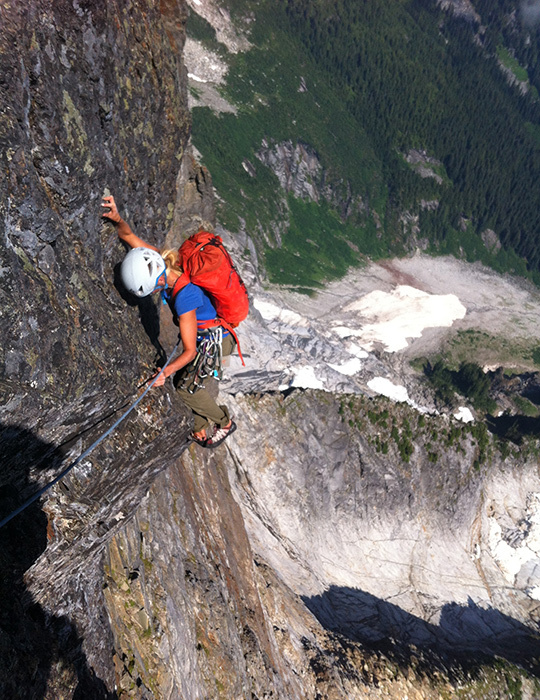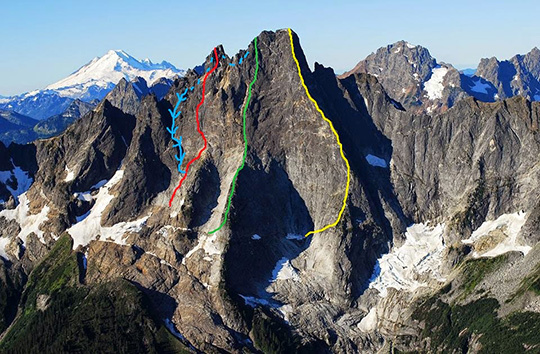
On August 30, Marc-Andre Leclerc approached British Columbia’s Slesse Mountain intent on a solo triple linkup of the East Pillar, Navigator Wall and Northeast Buttress, a combination that would amount to more than 7,000 feet of technical climbing with 3,500 feet of technical descent. The following is his a version of his account originally published on his blog.–Ed.
Shifting my weight back and forth delicately between small friable edges near Slesse Mountain’s East Pillar (ED1: 5.10c), I press my cheek against dark stone, prying outwards on a favorably positive edge to see if the hold flexes. It does. I leave a white, chalky handprint on the rock to remind myself not to use the edge as a foothold as I move higher.
Just a week earlier, my friend Tony took an unexpected fall on this very same pitch after his footholds crumbled. This weighs heavily on my mind as I commit to a high-step and begin to search for a hold with my right hand. A two-finger side-pull with a conveniently located thumb catch materializes, and I rock over onto the high foot, holding my breath, praying the edge doesn’t crumble as I make the long reach to a solid hold.
It’s not often that I find myself using small thumb-derclings while free soloing in the alpine. But now they help me stay in balance as I tiptoe left to better holds and a belay ledge. From there, I rejoin the regular East Pillar, having traversed left seeking solid rock.
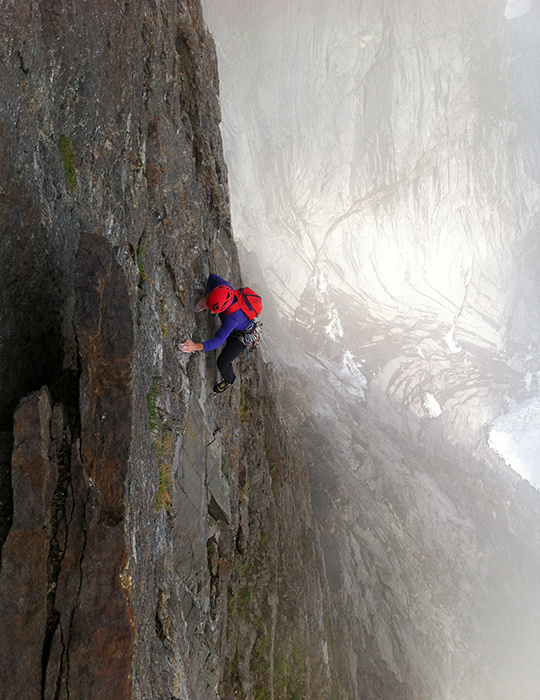
The climbing on the next two pitches is supposed to be the crux of the East Pillar, but I know it’s a fair bit easier than the pitch I just climbed, with larger, more positive holds. To my right, I can see two friends from Squamish waking up on their Northeast Buttress bivy ledge. We exchange waves as I continue upwards, the climbing now less stressful and quite fun. I climb through my favorite pitch, the “crux,” a 5.10+ corner and continue into the swirling clouds and fog above.
I imagine falling off, flying through the dense mist, unable to see the inevitable end far below. But I’m not going to fall, and I smile as I race up to the summit ridge and check the time. Two hours to free solo the East Pillar, I think to myself, not bad.
I continue along the south ridge and then descend, essentially reversing the Southeast Buttress (D+: 5.7) of the South Peak, which bring me to the base of my next objective: the Navigator Wall (ED1: 5.10d). The Southeast Buttress and Navigator Wall share the same first two pitches, so I traverse a grassy ledge and scramble the moderate terrain to the base of the first crux pitch. I check the time here–9:36 a.m.–about an hour and a half since I began my descent from the top of East Pillar. Faster than expected.
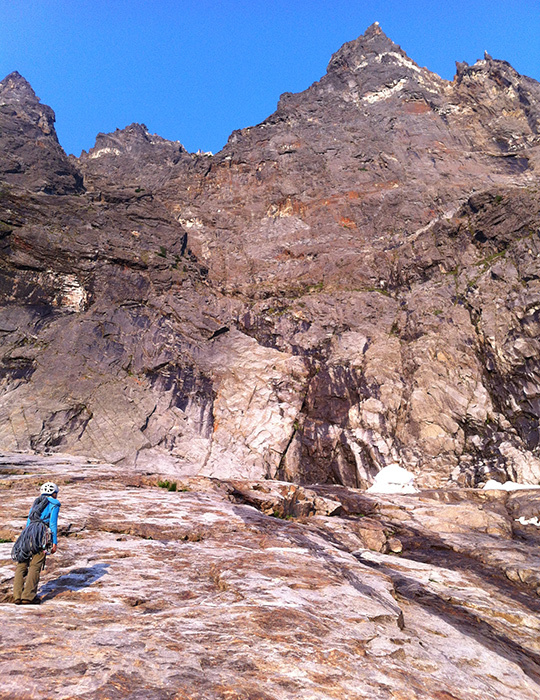
The Navigator Wall has a reputation for unpleasant climbing on loose, dirty rock, but it remains my favorite route on Slesse. The line is badass, the climbing steep and exposed, and in contrast to the East Pillar, the upper pitches are some of the best.
Switching back into rock shoes, I start up the 5.10+ overhanging corner, being careful to dodge loose blocks along the way. Through the vertical and positive climbing, I reach a solid jug with one hand and kick my feet off the wall with a loud “Whoop!”
On a chossy, overhanging diorite headwall guarding the upper pitches, I move delicately, testing each hold methodically as I navigate a series of loose 5.10 roofs. The final moves of the headwall are some of the wildest. Exiting the security of a corner, I hand-rail across an overhanging wall to mantle onto the slab above. My feet cut as I campus across the rail, and I catch a small glimpse of the cirque 1,700 feet below before rolling over the lip on a bomber foothold.
As I cruise up slammer hand jams on Pitch 18, the clouds thicken. One more pitch brings me to the airy summit of the spire, nearly an hour and 15 minutes after I started. I don’t linger on the summit for long, wanting to be off the mountain in case it begins to rain. I start down the Southeast Buttress route for a second time, moving quickly and deliberately.
On long solo days, I often find myself repeating mantras in my mind. As I make my second descent of the day, moving smoothly and executing slick cross-through moves with my feet as if I were dancing my way downwards through the clouds, my thoughts are particularly amusing. I feel like a cat, I feel like a ninja! I feel like a ninja cat! An ALPINE ninja cat! And repeat….

Back on the lower slabs at noon, I seriously contemplate taking the easy way out and hiking the trail back to where I had planned to meet my girlfriend, Brette, who was going for a solo ascent of the North Rib (TD: 5.9). I tell myself that the clouds are becoming too threatening, that I have already climbed the Northeast Buttress (TD: 5.9) too many times and that my knees are feeling a bit sore.
But it’s only noon. I know if I bail now I will be upset with myself in the future. I have no desire to solo the East Pillar again in order to do the triple linkup. This is my chance, so I start jogging towards the base of the Northeast Buttress.
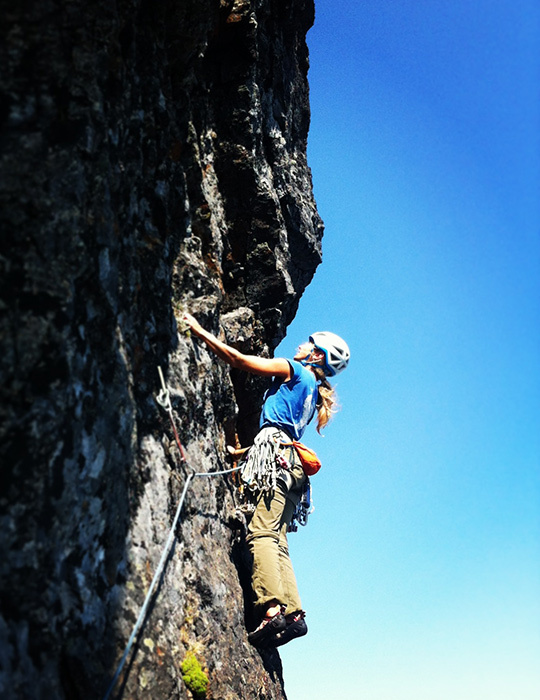
With Parov Stelar’s “Catgroove” blasting in my ears, I take off as quickly as I can. Taking the Beckey ramps, I avoid the 5.10a crux mid-route so I can keep scrambling in approach shoes, moving as quickly as possible. As I pass the bivy ledge mid route, I glance at my watch: 30 minutes. I continue up, breathing heavily.
I bump into two parties, stopping to chat and give some beta for the descent before finding myself on the summit an hour and 10 minutes after starting the route.
Descending and making it to the alpine meadows below the north face of the mountain at around 4:00 p.m., I suddenly realize that if I boogie I have a chance at making the round trip from my starting point in 12 hours. A total time geek in the mountains, I get psyched on the challenge, so I plug my headphones back in and start running down the flagged trail at top speed. I sprint back to the memorial where Brette is waiting and check the time. It is 4:24 p.m., exactly 12 hours and four minutes after I left.
